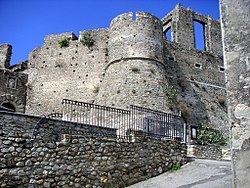Elevation 344 m (1,129 ft) Time zone CET (UTC+1) Local time Thursday 7:32 PM Postal code 88069 Dialling code 0961 | Demonym(s) Squillacesi Area 33 km² | |
 | ||
Frazioni Fiasco Baldaia, Squillace Lido Weather 16°C, Wind W at 27 km/h, 65% Humidity | ||
Squillace (Greek: Skyllision, Skyllition) is an ancient seaside town and comune, in the Province of Catanzaro, part of Calabria, southern Italy, facing the Gulf of Squillace.
Contents
- Map of 88069 Squillace Province of Catanzaro Italy
- History
- Medieval and early modern history
- Ceramics
- Notable people
- References
Map of 88069 Squillace, Province of Catanzaro, Italy
Squillace is situated on the east coast of Calabria, on the shores of an extensive bay, the Gulf of Squillace (Italian: Golfo di Squillace), which indents the coast of Calabria on the east as deeply as that of the Gulf of Saint Euphemia (Italian: Golfo di Sant'Eufemia) does on the west, with a comparatively narrow isthmus between them.
History
Squillace is known today as one of Italy's most important archaeological sites as well as a popular resort. The name derives from the ancient city of Scylletium, the principal ruins of which are located in the nearby comune of Borgia. The Roman statesman and writer Cassiodorus founded a monastery called Vivarium on his family estates on the shores of the Ionian Sea in the 6th century AD. This monastery was on the site of the modern Santa Maria de Vetere near Squillace.
Medieval and early modern history
Ceramics
Production of highly prized terra cotta has been an important part the local economy for centuries; Cassiodorus makes several mentions of it in his writings. Squillace is the home of the pignatari style of ceramic artistry. The name is derived from the Italian word pignata, an earthenware container used for cooking beans over an open fire.
